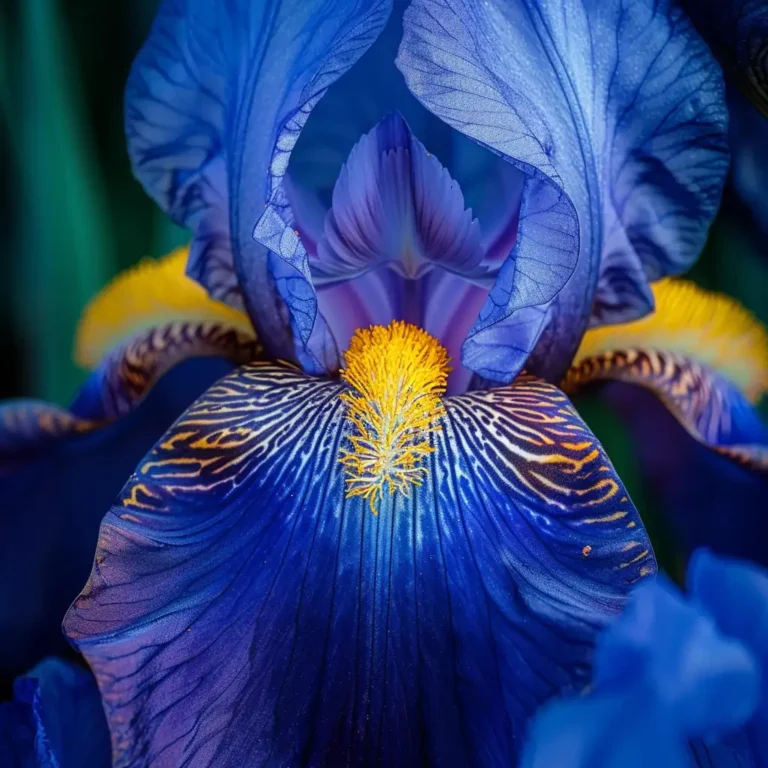Introduction
The Mystic Blue Iris (Iris germanica) is a stunning addition to any garden, renowned for its captivating blue hues and striking appearance. Irises have long been cherished by garden enthusiasts, and the Mystic Blue Iris stands out for its unique beauty and ease of care.
History and Origin
The Iris germanica, commonly known as the bearded iris, has a rich history dating back to ancient times. The Mystic Blue Iris, a variety of this species, was discovered and cultivated for its exceptional color and form. This variety has gained popularity among gardeners for its distinctive look and adaptability.
Description and Characteristics
The Mystic Blue Iris is a perennial plant that typically grows to a height of 24-36 inches. Its flowers are known for their deep blue color, with intricate patterns and a velvety texture. The foliage consists of sword-shaped leaves that provide an attractive backdrop even when the plant is not in bloom. This iris blooms in mid to late spring, offering a burst of color that can brighten any garden space.
Growing Conditions
For the best results, plant the Mystic Blue Iris in well-drained soil. It thrives in full sun to partial shade and prefers moderate watering. Ensuring the soil is slightly acidic to neutral will promote healthy growth. These irises are quite resilient and can adapt to a range of growing conditions, making them a versatile choice for various garden settings.
Planting Mystic Blue Iris
- Best Time to Plant: Early fall or spring.
- Planting Depth: Ensure the rhizomes are just below the soil surface.
- Spacing: Allow 12-18 inches between plants for proper air circulation.
Maintenance and Care
Regular maintenance is key to keeping your Mystic Blue Iris healthy and vibrant. Here are some essential care tips:
- Fertilizing: Apply a balanced fertilizer in early spring and after the bloom period.
- Mulching: Use mulch to retain moisture and control weeds.
- Pruning: Remove spent flowers and trim back foliage in the fall.
- Pest and Disease Management: Watch for common issues like iris borers and fungal diseases. Regular inspection and prompt treatment can prevent serious problems.
Landscape Uses
The Mystic Blue Iris is a versatile plant that can be used in various landscape settings. It pairs well with other perennials and can be a focal point in garden beds, borders, or even as a standalone specimen. Consider planting it alongside complementary plants like peonies, daylilies, and hostas for a stunning display.
Benefits of Mystic Blue Iris
- Aesthetic Appeal: The deep blue flowers add a touch of elegance and sophistication to any garden.
- Ecological Benefits: Irises attract pollinators like bees and butterflies, supporting local ecosystems.
- Symbolism: In many cultures, irises symbolize hope, wisdom, and valor.
Popular Varieties of Blue Iris
While the Mystic Blue Iris is a standout, several other blue irises are worth considering:
- ‘Blue Rhythm’: Known for its historic significance and lovely blue flowers.
- ‘Mystic Art’: Features unique pink standards with blue falls.
- ‘Babbling Brook’: A traditional favorite with a beautiful blue hue.
Propagation Methods
Propagating Mystic Blue Iris can be done through division or seed propagation:
- Division: The most common method, usually done in late summer to early fall. Divide the rhizomes and replant them immediately.
- Seed Propagation: Less common, as it takes longer to achieve blooming plants. Plant seeds in well-drained soil and keep them moist.
Frequently Asked Questions
What are the ideal growing conditions for Mystic Blue Iris?
The Mystic Blue Iris thrives in well-drained soil with full sun to partial shade. It prefers moderate watering and slightly acidic to neutral soil.
How do I propagate Mystic Blue Iris?
The best method is division. Divide the rhizomes in late summer to early fall and replant them immediately. Seed propagation is also possible but takes longer to achieve blooming plants.
What are common pests and diseases affecting Mystic Blue Iris?
Common issues include iris borers and fungal diseases. Regular inspection and prompt treatment can help manage these problems effectively.
Conclusion
The Mystic Blue Iris (Iris germanica) is a beautiful and resilient addition to any garden. With its striking blue flowers and easy maintenance, it offers both aesthetic and ecological benefits. By following the guidelines outlined in this article, you can successfully cultivate and enjoy this stunning iris in your own garden.

